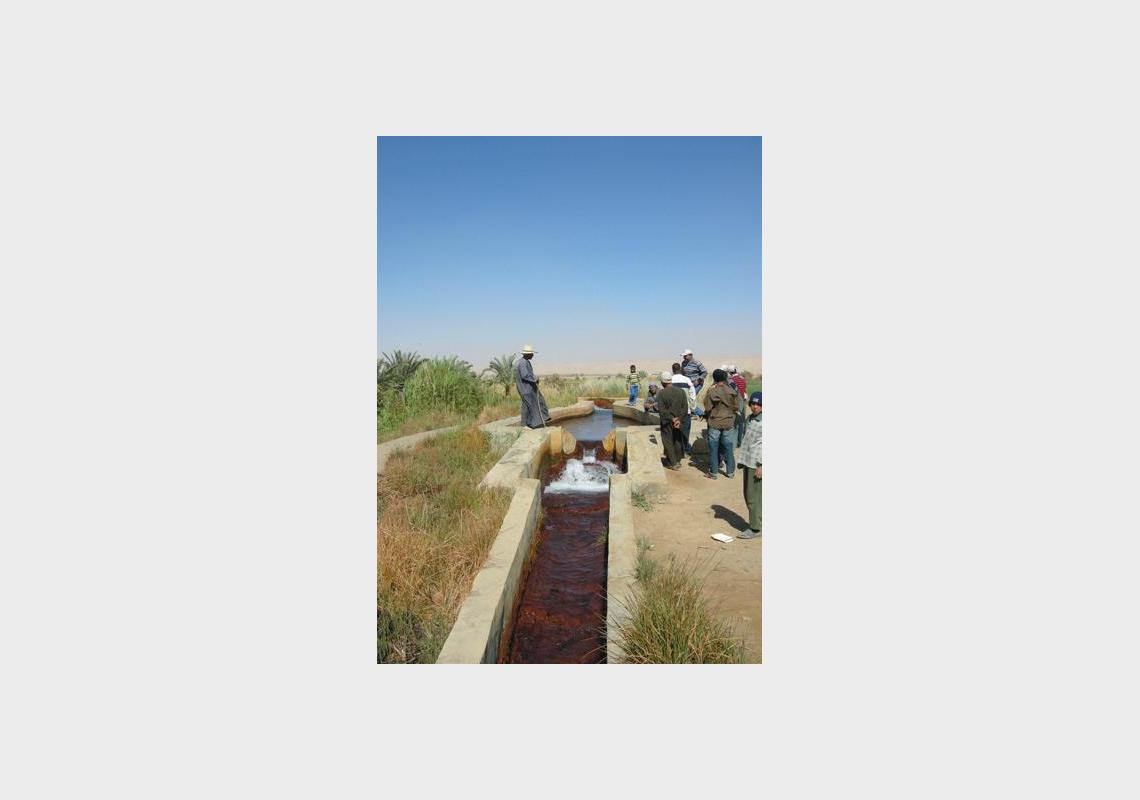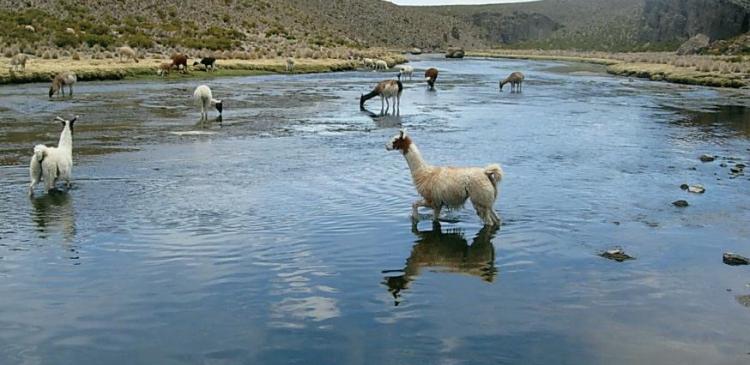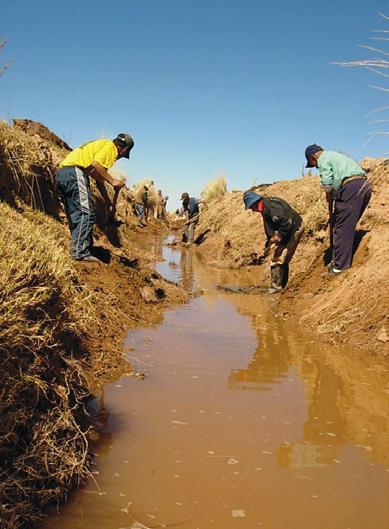Lining canals led to saving water and more equity in access and use of water in Abu Minqar, Egypt.
Written by Karl Nerenberg and Michelle Hibler
Solutions to the problem have long focused on increasing water supplies through technological means — dams, diversion of water streams, and desalination, among them. But they aren’t enough: meeting the world’s water needs also requires better water management and effective institutions — it needs people. That is the thrust of research supported by Canada’s International Development Research Centre (IDRC). The three projects described below — in Egypt, Bolivia, and Burkina Faso — tell a compelling story of water and people and show how science can support the formulation of sound policies, provide tools for communities to find their own solutions, and lead to strong institutions to ensure that the gains are sustained.
These projects also clearly show that accessing, distributing, sharing, and conserving water requires a strong institutional framework.
Egypt: Greening the desert sustainably
Abu Minqar is an eight-hour drive from Cairo through a landscape of rock, sand, exotic limestone formations, and very few signs of life. Yet this oasis settlement, deep in Egypt’s Western Desert, is a thriving agricultural community.
The community’s centuries-old appearance belies the fact that it was established only in 1987, part of an Egyptian government resettlement program designed to relieve the overcrowded Nile Valley and Delta. That program has seen about two million Egyptians move to reclaimed lands in the Sinai Peninsula and the desert adjacent to the Nile River Valley. Such desert plots now account for almost 25% of Egypt’s 3.2 million hectares under cultivation.
Home to about 4,000 people living on 1,600 hectares of land, Abu Minqar is one of Egypt’s most isolated communities. As with the other oasis communities west of the Nile, the village draws all of its water through 17 wells from the vast Nubian aquifer. But the aquifer is not being replenished. Based on current and anticipated rates of usage, the water is expected to last anywhere from 100 to 300 years.
In 2006, a geographer and an irrigation engineer from the Desert Development Center of the American University of Cairo began working with the community to find ways to use water more efficiently and sustainably. IDRC supports the team’s work, which builds on the community’s own efforts to organize and improve farming techniques.
“One thing we quickly discovered,” says geographer Tina Jaskolski, “is that there was no widespread awareness in the settlement that the water supply is not infinite.”
Most of Abu Minqar’s farmers irrigate by simply flooding their fields with water from canals. But farmers did not realize that the canals — mostly simple mud trenches — were less efficient if there were reeds growing in them and if they were not lined to prevent seepage. The research team’s analysis showed that as much as half the water could be lost in the journey from well to field.
The researchers worked with a newly formed local association to improve the irrigation system and explore ways of increasing agricultural output.
With support from Deutsche Gesellschaft für Technische Zusammenarbeit, (the German cooperation agency) and the American University of Cairo, the community banded together to line one of the main irrigation canals with cement. Water channelled through the lined canal takes only 10 to 15 minutes to reach the fields, instead of three to four hours in the unlined, weed-choked canals. Leeching is reduced. Community members also developed a sense of ownership for the canal after having invested in the infrastructure.
The community also built a “shade house” to experiment with new crops that could have important market value. The farmers have discovered that the yields of garden vegetables, such as fava beans and potatoes, are higher when grown under the protective screens.
The shade house is also an excellent place to try out sustainable irrigation practices, such as sprinkler and drip irrigation. Community leaders expect that these practices will soon become widespread.
And there’s more: with the research team’s support and encouragement, the Abu Minqar community association applied for and received grants from Canadian and German development agencies to set up experimental solar energy facilities to generate electricity for cooling and storing food, especially milk products.
Last but not least, the association was able to arrange a meeting with Egyptian government officials in Cairo. This is a breakthrough for a remote community and the beginning of a new, constructive relationship between the people of Abu Minqar and the far-away authorities.
Bolivia: Bringing science to bear on policies
Irrigation is an ancient practice in Bolivia. Indigenous peoples were irrigating their lands long before the arrival of Europeans. Traditionally they grew grains and a variety of vegetables, including beans, tomatoes, and chili peppers. More recently, they introduced cash crops such as rice and soy.
But water has long been a controversial issue in the Andean country. It is scarce in much of the country. Elsewhere, access to supplies is highly contested. It has been difficult to reach agreement on how the resources should be regulated and who should have legal rights over it.
The issue came to a boiling point in 1998 when the government proposed legislation that allowed for privatization of water and gave a private, foreign-owned company a concession to sell water in Cochabamba, without regard for the customary rights of water users. The “Water Wars” erupted.
The conflict was finally resolved, in the spring of 2000, when the Bolivian government returned water to public administration. To make this happen effectively, it was necessary to understand the complex, traditional system of water use, and to reconcile the worlds of science and engineering with indigenous practices.
That was the challenge a group of Bolivian researchers and practitioners took on with IDRC support.
Working with irrigator and farmer groups, these researchers set out to document indigenous knowledge, practices, and customary rights over water management and uses. Using a Danish computer model known as “Mike Basin,” the researchers simulated water use. Research issues, methods, and results were discussed and then developed with the participation of all concerned, from farmers and local groups to technicians, academics, and government officials.
The research scientifically showed the existence and efficiency of customary water distribution knowledge and practices and provided reliable data for water distribution policies and regulations.
In October 2004, the Government of Bolivia promulgated law number 2878 which recognizes traditional water rights and guarantees the right to water for irrigation and farming communities. It is one of the first times in Bolivia that evidence-based research has been used as the basis of legislation.
Today, what began as a loose group of motivated researchers is now a respected and awarded organization called Agua Sustentable. Its Director, Juan Carlos Alurralde, says that having a functional, publicly accepted water law has led to an unprecedented level of investment in new irrigation and drinking water systems and wastewater treatment plants in Bolivia. In 2010 the research contributed to the UN Resolution on Water as a Human Right.
More recently, Agua Sustentable used the same tools for defusing potentially grave international conflicts over water.
Flowing through Bolivia’s low-rainfall Altiplano region, the Mauri river “is a source of life for 70 highland communities,” says Alurralde. But local leaders in Tacna, Peru, didn’t see it that way. They wanted to divert water from the Mauri basin to their own desert area, to supply new mines and proposed export agricultural operations. Once again, solid evidence on water use showed that water resources were already stretched to meet existing needs. When Peruvian officials became convinced the research was valid, federal officials in both countries forged an agreement that no diversion would take place without scientific support.
A bi-national commission has been struck, and hydrometric stations now monitor how much water flows across the border. If the water had been diverted as planned, “at least one-third of the highlands of Bolivia would not have had enough water to survive,” Alurralde says. Instead, a new form of cooperation — based on science — now provides a promising model for resolving international water disputes.
Burkina Faso: Giving voice to communities
If you travel to rural areas of Burkina Faso you will inevitably see villagers filling water pots at communal faucets that they share with thousands of others, then carrying those pots on their heads, often for many kilometres. But only the lucky get to use those communal wells. Many others must rely on unhealthy ground water, just below the surface of dried river beds, or from hand-dug traditional wells.
Unlike Bolivia and Egypt, irrigation is still quite rare in Burkina Faso. The main water challenge here is the daily hunt to find enough for the most basic needs.
In the early 2000s, the Burkina Faso government adopted an integrated water resources management strategy to meet at least some of the country’s water challenges. But rural communities were not consulted when that policy was developed, nor has it reached them to a significant extent.
IDRC-supported researchers have worked to make that connection happen. The Ouagadougou-based Centre d’études, de documentation, de recherches économique et sociale (CEDRES) focused on developing communications capacity in 15 villages. The goal was to help them forge a shared vision of the importance of water, express their needs, and engage in constructive dialogue with the authorities.
The project used traditional storytelling to theatre to community-based media (print and radio) to communicate its message. As a result, rural communities are now talking to each other about their water problems and are taking greater responsibility for how they themselves use and distribute water. For example, some have stopped consuming contaminated water without boiling it. Others have become more aware of polluting habits, such as allowing agricultural waste to contaminate the source of drinking water.
Dialogue among the communities has led to local leaders — a number of them women — taking on positions of responsibility on municipal councils. The communities involved in the project also succeeded in getting the attention of national water management authorities through a policy brief.
Other benefits have accrued to the communities. In the village of Tourny, for example, the people had a negative view of a nearby hydroelectric dam, in part because they did not perceive any benefit to them and had not been involved in its conception or development. They blamed the dam for poor water quality and recurring water shortages.
With the help of CEDRES, the Tourny villagers entered into discussions with the electric power utility, which led to the company’s agreeing to provide them with electricity. Community members are now reconciled with the dam and its operators are more open to dealing with villagers’ needs.
In Faniagara, villagers relied exclusively on water from hand-dug traditional wells and from a wetland area that, in addition to being contaminated, was not a year-round, reliable source. With the support of CEDRES, villagers organized themselves to raise money to finance a new, modern well. They also developed a system for wastewater containment to isolate wastewater from the sources of drinking water.
From common challenges, some shared lessons
These positive impacts are just the beginning. But they show what can happen when local people develop the capacity to communicate, to help themselves, and to engage in the policy process. And they show how research can lead to practical solutions.
Despite the differing locales and priorities, some common lessons can be drawn from this research:
(1) Focusing on and involving local communities ensures that the research is relevant to their needs.
(2) Providing access to knowledge and increasing organizational capacity can enable them to determine their own needs and devise their own ways of meeting those needs.
(3) Accurate scientific data is essential: advocacy supported by science can be extremely effective.
(4) Water management institutions have an important role to play and must be managed efficiently.
(5) Water management institutions need to give voice to the poor and to rural populations as well as to the more affluent and urban groups.
The three research teams also found — and they stress — that there is no contradiction between economic efficiency and being inclusive of everyone who needs water. Engaging and involving grassroots communities will produce more equitable and effective results, more efficiently.





